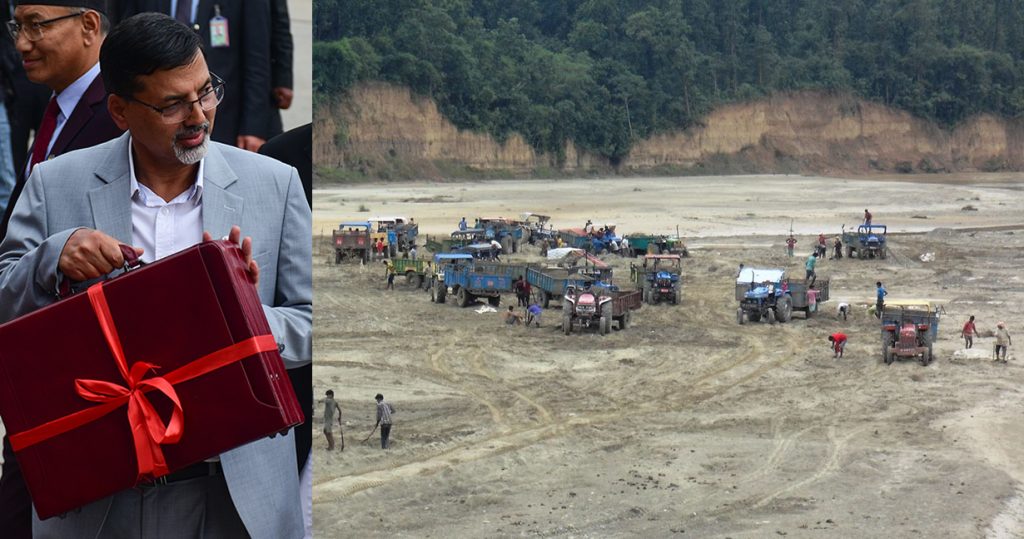The government has once again introduced a plan to extract and process stones and pebbles despite the Supreme Court’s order on June 18, 2021. In point number 124 of the new budget plan, it is mentioned that the Department of Mines and Geology will start the extraction of marble, granite, and precious metals like iron, stone, and rock from the potential locations identified in the Mahabharata region, after environmental assessment.
However, the department itself is not clear about the said plan. The spokesperson of the department, Narayan Baskota, says that they have no extraction plan. He further informs that the department is making efforts to understand the budget plan, adding, “Perhaps the government plans to conduct a feasibility study and that is why it has made such an announcement.”
Secretary at the Industry and Commerce Ministry Ganesh Prasad Pandey says the plan will have to await the environmental and feasibility as well as investment studies before it will be implemented. Neither is there a law that encourages coordination among the three tiers of government regarding the conservation and systematic use of natural resources as well as its budget. As it is not the ministry’s proposal, there is still a long way to go, he adds.
Conservationists and environmentalists, on the other hand, fear that once again the plan is to exploit the country’s natural resources, destroy the Chure region and desertify the Terai region, just like what the previous Oli government had planned.
The Oli way
The budget for the current fiscal year 2021/22, announced by the KP Sharma Oli-led government, had announced the extraction of stone, pebbles, and sand. In the plan announced in an ordinance on May 29 last year, it was mentioned that the trade deficit would be reduced by extracting stones and pebbles.
But, it faced a widespread protest including that from the opposition alliance. The alliance had argued the incumbent government was favouring the decision to appease the southern neighbour, India, and stay in power.
In a joint statement, Nepali Congress President Sher Bahadur Deuba, CPN-Maoist Centre Chairman Pushpa Kamal Dahal, CPN-UML leader Madhav Kumar Nepal, Janata Samajwadi Party Nepal Chairman Upendra Yadav and Rastriya Janamorcha Vice-chairperson Durga Paudel had stated, “It is a declaration of treason and genocide where the lives of common people will be put in endangerment with flood and drying up of water resources.”
Yet the Oli government had claimed the Chure region would not be destroyed. Whereas the then Finance Minister Bishnu Paudel tried to stop the protest by claiming that he was committed to the protection of the Chure region, adding the extraction only from the mines in the Mahabharat region.
Subsequently, seven writ petitions were filed at the Supreme Court claiming the extraction would desert Terai and exploit the fundamental rights. Hence, the court put a halt to the plan stating the government was exploiting the available natural resources in the Chure region in the name of reducing the budget deficit.
The decision was made by a bench of the then Chief Justice Cholendra Shamsher Rana, justices Deepak Kumar Karki, Meera Khadka, Hari Krishna Karki and Bishowambhar Prasad Shrestha.
But, despite knowing the court’s decision, an official of the Ministry of Finance says the recent decision to resume extraction in the Chure region was made to serve the interests of a limited group.
Vested interest

A source from the Ministry of Commerce claims the interest group has once again made plans to extract the stones and pebbles from the Chure region in this year’s budget as well. He adds they claim to excavate not from the region but from 92 mines outside it where the environmental impact assessment has been done.
But, interestingly, most of the mines identified are located around Chure, Bhavar, Siwalik and other river systems that include the areas around Dhankuta, Lalitpur, Morang, Makawanpur, Palpa, Arghakhanchi, Chitwan, Doti, Dadeldhura, Pyuthan, Surkhet, Salyan, Sindhuli and Udaypur.
Earlier, as the mines were in the forest areas, the Department of Mines and Geology was not able to issue licences for extraction. This year, the extraction announcement was included under the Ministry of Forests. The official claims it confirms that there is a vested interest at play to issue the licences and extract the resources. “Given the lack of clear laws and policies, it is more complicated. The interest group wants to export local resources from the Chure region to India.”
Wrong pathway

According to Vijay Kumar Singh Danuwar, a former member of the Chure Terai-Madhesh Conservation and Development Committee and a Chure region expert, there is an evident risk of destruction of the Mahabharat and Chure regions in the long run.
According to experts, one of the low hills in the Mahabharat range that stretches east-west is the Chure/ Shivalik hills. It was formed about 40 million years ago by the accumulation of gravel in the middle of geological cracks. The Chure region is spread over 37 districts from Ilam in the east to Kanchanpur in the west. The Chure landmass is considered to be unique and sensitive to natural and ecological systems.
The Chure region is considered to be highly sensitive due to its fragile topography, poor soil nature, loss of biodiversity and short-term heavy rainfall. However, expert Danuwar says the activities taking place in the Mahabharat mountain range above Chure are also connected with Chure and Terai Madhesh regions. “Excavating the mountains of the Mahabharat range produces only 25 to 30 per cent of exportable stone and pebbles, and the remaining 70 to 75 per cent of the debris flows into the Terai region,” he says.
Environmentalist and Chure region expert Vinod Bhatt expresses concerns that the government has brought a programme similar to last year’s plan by twisting the words. He adds that it would be unfortunate for the country if the plan to export stone from mines in the Chure region was taken forward.
He accuses the government of not following the right path at a time when many development works need to be done in the country and proper management of stone and pebbles are required for that. “Projects about the environment are only limited in their political speeches. But, when it comes to money and business, our political parties agree,” he says.
This story was translated from the original Nepali version and edited for clarity and length.



























